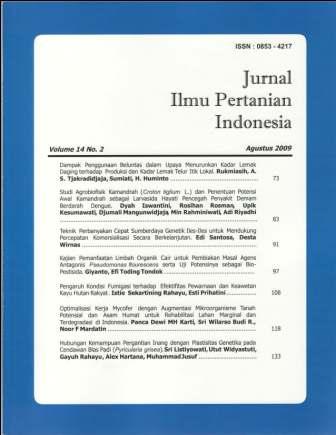Kajian pemanfaatan limbah organik cair untuk pembiakan masal agens antagonis pseudomonas flourescens serta uji potensinya sebagai bio-pestisida
Abstract
Pseudomonas fluorescens has been well known as biological control agent for plant diseases control. The ;:>roblem to apply the agents widely in the field or in the level of farmer is limited technology of mass production Nith low cost, due to the simple technology of propagation has not been yet available. The objective of this research is to study the potency of liquid organic wastes as media for mass production of P. f/uorescens and to formulate them as bio-pesticide. The results showed that modification of coconut water to pH of 7.0 could be used as media for growing P. flourescens. The P. fluorescens also could grow well in livestock liquid waste by adding 10% meat extract. On the other hand, the liquid tofu waste and liquid compost waste became good media for growing of P. fluorescens by addition of 10°/o meat extract and 1.2S0/o sugar. Tetes tebu will be very good media for P. f/uorescens at S% final concentration and by adding of 10°/o meat extract and 2.S0/o of sugar. The P. fluorescens showed high antagonistic effect to Ralstonia solanacearum and Sclerotium rolfsii in all of modified liquid organic wastes media. Survival and antagonisctic activity of P. fluorescens in modified organic liquid wastes stored at S°C or room temperature were 12 weeks. In vivo antagonistic and plant growth promoting activity showed that P. fluorescens grown in liquid organic waste suppressed the incidence of stem rot diseases caused by Sclerotium rolfsii and increased the vigor of plant growth on watermelon. Formulation of the P. Fluorescens grown in modified coconut water gave the best performance of P. fluorescens in supppressing of plant diseases and inducing plant growth. The product of BeMOR(e) (beneficial microorganism) from the result of this research will be proposed to be patented.Downloads
References
Duffy BK, Defago G. 1999. Environmental factor modulating antibiotic and siderophore biosyntesis by Pseudomonas fluorescens biocontrol strain. Applied and Environmental Microbiology 65(6):2429-2438.
Giyanto, A. A. Nawangsih dan K. H. Mutaqin. 1999. Analisis keragaman molekuler Pseudomonas kelompok fluorescens dengan teknik RAPD (Random Amplified Polymorphic DNA) dan studi potensi antagonistic terhadap Ralstonia solanacearum pada tomat. Laporan Penelitian Proyek Pengkajian dan Penelitian Ilmu Pengetahuan Dasar. Dirjen Pendidikan Tinggi. Departemen Pendidikan Nasional.
Hamdan H, Weller DM, Thomashow LS. 1991. Relative importance of fluorescens siderophores and other factors in biological control of Gaeumannomyces graminis var. tritici by Pseudomonas fluorescens 2-27 and M4-80R. Applied Environmental Microbiology 57(11):3270-3277.
Heeb, S., C Blumer, and D. Haas. 2002. Regulatory RNA as mediator in GacA/RsmA-dependent global control of exoproduct formation in Pseudomonas fluorescens CHAO. J. Bacteriol. 184:1046-1056.
Howell, C. R. and R. D. Stipanovic. 1980. Supression Phytium ultimum induced damping-off of cotton seedlings by Pseudomonas fluorescens and its antibiotic pyoluteorin. Phytopatology 70:712-715.
Igo, M. and Losick, R. 1986. Regulation of promoter that is utilized by minor formsof RNA polymerase holoenzyme in Bacillus subtilis. J Mol. Biol. 191:615-624.
Loper, J. E. 1988. Role of fluorescens siderophore production in biological control of Pythium ultimum by a Pseudomonas fluorescens strain. Phytopathology 78: 166-172.
Paulsen Ian T., Caroline M Press, Jacques Ravel, Donald Y Kobayashi, Garry S A Myers, Dmitri V Mavrodi, Robert T DeBoy, Rekha Seshadri, Qinghu Ren, Ramana Madupu, Robert J Dodson, A Scott Durkin, Lauren M Brinkac, Sean C Daugherty, Stephen A Sullivan, Mary J Rosovitz, Michelle L Gwinn, Liwei Zhou, Davd J Schneider, Samuel W Cartinhour, William C Nelson, Janice Weidman, Kisha Watkins, Kevin Tran, Hoda Khouri, Elizabeth A Pierson, Leland S Pierson III, Linda S Thomashow & Joyce E Loper. 2005. Complete genome sequence of the plant commensal Pseudomonas fluorescens Pf-5. Nature Biotechnology. 5:873-878.
Rodriguez, F. and W. F. Pfender. 1997. Antibiosis and antagonism of Schlerotinia homeocarpa and Drechslera poae by Pseudomonas fluorescens Pf-5 in vitro and in planta. Phytopathology 87:614-621.
Sambrook, J., E. F. Fritsch, and T. Maniatis. 1989. Molecular cloning: a laboratory manual, 2 nd ed. Cold Spring Harbor Press. New York.
Schnider, U., C. Keel, C. Blumer, J. Troxler, G. Defago, and D. Haas.1995. Amplification of housekeeping sigma factor in Pseudomonas fluorescens CHAO enhances antibiotic production and improves biocontrol abilities. J.Bacteriol. 177:5387-5392.
Sharifi-Tehrani, A., M. Zala, A. Natsch, Y. Moenne Loccoz, and G. Defago. 1998. Biocontrol of soil-borne fungal plant diseases by 2,4-diacetylphloroglucinol-producing fluorescens pseudomonads with different restriction profiles of amplified 16S rRNA. Er. J. Plant. Pathol. 104:631-643.
Vigliar R, Sdepanian VL, Neto UF. 2006. Biochemical profile of coconut water from coconut palms planted in an inland region. Jornal de Pediatria 82(4):308-312.
Xu, G. W., and D. C. Gross. 1986. Selection of fluorescens pseudomonads antagonistic to Erwinia carotovora and suppressive potato seed piace decay. Phytopathology 414-422.
This journal is published under the terms of the Creative Commons Attribution-NonCommercial 4.0 International License. Authors who publish with this journal agree to the following terms: Authors retain copyright and grant the journal right of first publication with the work simultaneously licensed under a Creative Commons Attribution-NonCommercial 4.0 International License. Attribution — You must give appropriate credit, provide a link to the license, and indicate if changes were made. You may do so in any reasonable manner, but not in any way that suggests the licensor endorses you or your use. NonCommercial — You may not use the material for commercial purposes.


















